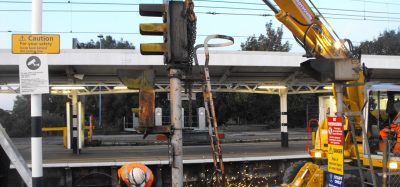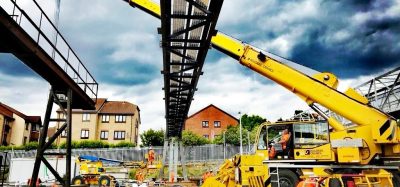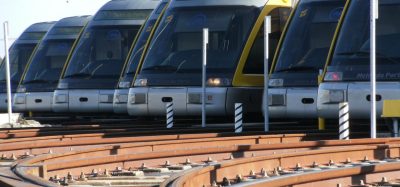Successful completion of Sweden’s biggest ever signal replacement
Posted: 27 September 2008 | | No comments yet
During the Easter period of 2008, Banverket Produktion carried out the biggest ever signal replacement in Sweden and one that could possibly be considered the biggest in the whole of Europe.
During the Easter period of 2008, Banverket Produktion carried out the biggest ever signal replacement in Sweden and one that could possibly be considered the biggest in the whole of Europe.
During the Easter period of 2008, Banverket Produktion carried out the biggest ever signal replacement in Sweden and one that could possibly be considered the biggest in the whole of Europe.
For the normal train or commuter passenger, the extraordinarily comprehensive work that has been carried out is not visible, but it is noticeable by the fact that rail traffic can run at much closer intervals and is less sensitive to disturbances than previously. In addition, the new signal boxes are a precondition to be able to build the new City Track.
Planning, demolition and implementation
The project had been preceded by rigorous planning and entailed the demolition of half of the signal boxes at Stockholm’s Central Station, at the same time that a completely new signal box in Karlberg was taken into operation. For this to be possible to implement, all north-bound rail traffic was shut down during the majority of the Easter weekend.
“We had two alternatives; to completely close down during a limited period of time and make a massive effort, or allow the connections to be made over a longer period of time with a great deal of disturbance as a result,” explains Bo Löwenberg at Banverket’s Investment Division, who is the client for this particular project. “The train operators were in agreement that it was better to do the work in a single intensive operation and have everything completed in time.
Easter work
In total, 210 people took part in the operation that started at midnight of the night of Good Friday and continued until 12:00 on Easter Monday. During 84 intensive hours, 160 signal technicians who were called in from Banverket Produktion over the whole of Sweden, were occupied with both internal and external installations. In total, 4,200 kilometres of cable were connected to more than 40,000 connection points. After each individual phase, inspections and tests were carried out by some 50 technicians from Banverket Projektering.
Completion ahead of schedule
At 11:53 on Easter Monday, the work was completed and the track area could be handed back to the owners – seven minutes ahead of the planned time. When the first train whistled passed a few minutes before twelve, those responsible were able to verify that everything had functioned according to plan.
“The signal connection project in Karlberg clearly shows that, within Banverket Produktion, we can perform and mobilise when really needed,” says Magnus Sjöberg, Contracting Manager at Banverket Produktion. “I would dare to suggest that no other contractor could have successfully completed an assignment of this nature and we are delighted and proud to say that our customer is extremely satisfied.
Background on Banverket Produktion
Banverket split from SJ (Swedish Railways) in 1988. Ten years later, Banverket Produktion, which builds and maintains the rail tracks, split from Banverket, which owns the rail network.
Since 2002, we have been competing in an open market. We have developed from being a part of a government authority to becoming one of many contractors in the Swedish rail market – a development which we embrace.
Exploring new markets
Competition is good. It keeps us alert. Furthermore, an open market works both ways; it gives us the opportunity to explore new markets – in Denmark and Norway for example. Our vision is to be the leader in Scandinavia at building and maintaining railways. But that begs the question: what does ‘leading’ really mean? Quickest? Cheapest? Safest? Most environmentally friendly?
Customer satisfaction
For us, it means satisfying three levels of customer. The first level is our customer, that is to say those who own the railways. In Sweden this means Banverket of course, but it also includes SSAB, Gothenburg Harbour, LKAB, SL and the Inland Railway.
The next level is our customers’ customers – the companies which run the trains – for example SJ, Veolia, Tågkompaniet or Danske Statsbaner. Last but not least are our customers’ customers’ customers – the rail passengers and the companies that wish to transport goods. This could be someone who commutes daily between Malmö and Lund, or SSAB, who transport over 20,000 tonnes of steel every single day of the year.
In our business plan, the connection is stated thus: ‘Banverket Produktion builds and maintains rail tracks with Scandinavia as our base. Through development and cooperation with our customers, we contribute to a safe, punctual and environmentally-aware transport system’.
Past changes make a better today
The changes of the past ten years have resulted in the fact that today our customers enjoy larger and better rail maintenance for their money – and it is Banverket Produktion that has encouraged this development.
Experience
We are Scandinavia’s leading railway contractor; with 150 years experience, 2,500 specialists and 450 tailor-made vehicles – we can manage pretty much anything. For example, we are able to build 25 kilometres of rail track per day. This is the equivalent of 9,125 kilometres per year. By comparison, the Trans-Siberian Railway – the world’s longest railway – and stretches 9,300 kilometres from Moscow to Vladivostok and took 25 years to build!
Specialised competence
So we can undertake huge projects. But we’re also good at the little things. Our sheer size means that we have specialists in many fields, and we can maintain these unique levels of specialised competence, since it’s always required somewhere in our organisation.
We are also able to provide lightning-fast crisis management.
Turn-around times
When a freight train derailed and tore up sections of the Västra Stambanan near Alingsås, we had trains running within 12 hours. We then replaced 6,000 sleepers in 36 hours, and got traffic going on one of Sweden’s busiest railway lines in record time. Our customers trust us, and know that we can turn up with people and machines at short notice anywhere in the country. We have bases from Abisko in the north to Malmö in the south. Banverket Produktion has a breadth and depth that is unrivalled in the railway industry.
Less disruption is important
We undertake every effort to keep traffic delays to the very minimum. This requires effective leadership, planning, organisation and choice of working practice. A good example of this is when we changed the points on the Stambanan just south of Stockholm – one of the busiest and most delay-sensitive tracks in the country. We strive to conduct repair work at night to avoid disruption, but changing a set of points takes 15 hours, and neither we nor our customer wanted to close the line. So we split the points into two parts, took out one part per night, and completed the job over a Saturday and Sunday night. In this way we managed to change the points without any disruption or delays. It’s perhaps not the most remarkable achievement ever, but it reflects the way we approach our work. The less we disrupt, the better we have done our job.







